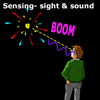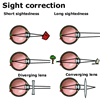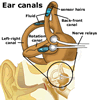 Our
senses are our windows to the outside world through which we receive information
about the surrounding environment so that we can respond to ensure our
survival.
Our
senses are our windows to the outside world through which we receive information
about the surrounding environment so that we can respond to ensure our
survival.
Sensory receptors contain nerve cells which, when activated, convert stimuli into nerve impulses which are transmitted to the brain. Here they become the experience of sight, sound, taste, touch or smell.
Sight
Animals which live in very dark habitats (e.g. caves or at extreme depths
under the sea) have very simple eyes or none at all.
For humans, however, the organs of sight, our eyes, provide us with continuous information about our changing world.
The positioning of our eyes gives us a wide angle of view, and the two eyes working simultaneously (stereoscopic vision) help us determine distance and provides us with 3D images of the world around us.
The structure of the eye
 The eye is made up of a lens through which rays of light from a viewed
object are directed and focussed, so that an image of the object falls
on the retina which is like a screen at the back of the eye.
The eye is made up of a lens through which rays of light from a viewed
object are directed and focussed, so that an image of the object falls
on the retina which is like a screen at the back of the eye.
The light-sensitive rods and cone cells in the retina detect the image, which is converted to nerve impulses and sent immediately to the brain along the optic nerve. In the brain the image is re-formed and we "see" the object. Damage to the optic nerve or the sight centre of the brain result in blindness.

|
Light in the eye |
By the action of small muscles, the lens can change shape to focus on distant or near objects. This is called accommodation.
 In people who are long-sighted or short-sighted, the lens does not
adjust sufficiently so that the image does not focus on the retina. It
therefore appears blurred. Adding other lenses, such as spectacles, overcomes
these problems.
In people who are long-sighted or short-sighted, the lens does not
adjust sufficiently so that the image does not focus on the retina. It
therefore appears blurred. Adding other lenses, such as spectacles, overcomes
these problems.
To compensate in the dark or bright sunlight, the iris can change the size of the pupil to allow more or less light to enter.

|
Pupil dilation |
Hearing
 Sounds are transmitted to our ears by air that has been caused to
vibrate. The sound waves are collected and funnelled by the outer ear
(the pinna) through the ear canal. This causes the taut eardrum to vibrate.
This vibration is conveyed through the middle ear by three tiny bones
(hammer, anvil and stirrup) to the oval window. Vibrations here produce
pressure changes in the fluid of the cochlea (inner ear) which affect
tiny sensitive hairs linking up with nerve fibres through to the auditory
nerve and hence to the brain for translation as "sound".
Sounds are transmitted to our ears by air that has been caused to
vibrate. The sound waves are collected and funnelled by the outer ear
(the pinna) through the ear canal. This causes the taut eardrum to vibrate.
This vibration is conveyed through the middle ear by three tiny bones
(hammer, anvil and stirrup) to the oval window. Vibrations here produce
pressure changes in the fluid of the cochlea (inner ear) which affect
tiny sensitive hairs linking up with nerve fibres through to the auditory
nerve and hence to the brain for translation as "sound".
Differences in volume, pitch and rhythm are all conveyed as nerve impulses.
Balance
 The inner ear also has fluid-filled semi-circular canals with sensitive
hairs which respond to gravity and movement. When "off balance",
different cells are stimulated notifying the brain of our disorientation
which results in responses being sent to the leg muscles to restore balance.
The balance mechanism in our ears works together with special nerve endings
in the skeletal muscles (proprioceptors) which also detect minor changes
of balance. Both systems together allow immediate, continuous and unconscious
readjustment by the body.
The inner ear also has fluid-filled semi-circular canals with sensitive
hairs which respond to gravity and movement. When "off balance",
different cells are stimulated notifying the brain of our disorientation
which results in responses being sent to the leg muscles to restore balance.
The balance mechanism in our ears works together with special nerve endings
in the skeletal muscles (proprioceptors) which also detect minor changes
of balance. Both systems together allow immediate, continuous and unconscious
readjustment by the body.
| Copyright owned by the State of Victoria (Department of Education and Early Childhood Development). Used with Permission. |